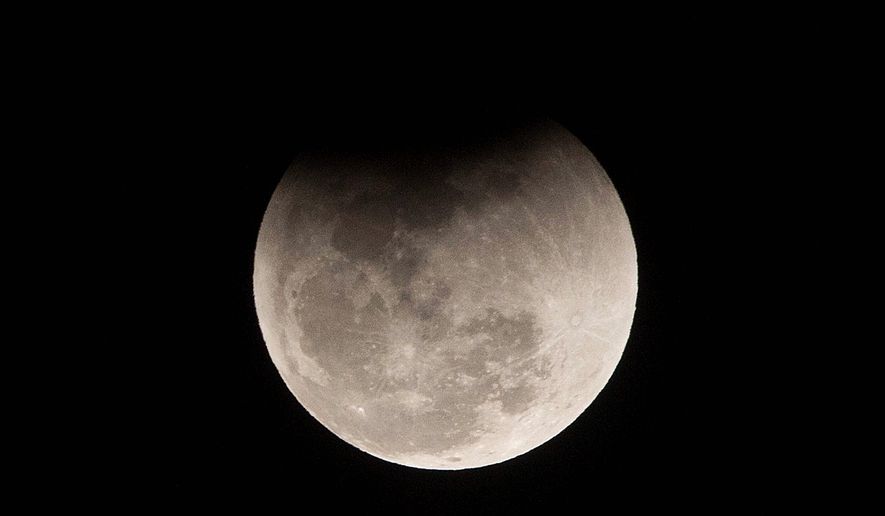NASA is buzzing with excitement these days about its ambitious new mission to return to the moon — this time to stay.
The agency set an aggressive timetable to have the Gateway space station orbiting the moon by 2024, then begin ferrying astronauts from the station to the lunar surface sometime after 2026.
And that is just the beginning.
Gateway also will serve as an outpost for deep space science and exploration, including a manned mission to Mars in the 2030s, according to NASA.
The timeline, which some scientists say is overly optimistic, isn’t fast enough for President Trump, who dreams of sending humans on the 33.9-million mile journey to the red planet during his administration.
“We want to try to do it during my first term or at worst during my second term. So we’ll have to speed that up a little bit, OK?” he quipped in a video call last year with NASA astronauts aboard the International Space Station.
The president likely will have to make do with getting astronauts aboard Gateway before the end of a potential second term.
Just hitting the 2024 goal will take major technical feats and a bunch of cash. So far, the Trump administration and Congress have kept the money flowing, with $19.5 billion in 2018 and $19.9 billion teed up for 2019.
NASA has spent years drafting plans for Gateway, officials known as Lunar Orbital Platform-Gateway or LOP-G, but the space agency has not yet built any of it.
The design for the 55-ton orbiting station consists of several components: a power and propulsion unit, a habitat module to house astronauts, an airlock section where spacecraft will dock and a massive robotic arm.
The first section NASA wants to finish is the power and propulsion element, currently scheduled to deploy in 2022.
If everything goes according to plan, the next pieces — habitat and airlock modules — would quickly follow. They would be delivered by the agency’s new deep space rocket, the Space Launch System or SLS.
Heralded as the world’s most powerful rocket, SLS has been under development for a decade and is scheduled for its debut flight in 2020. The flight, code-named EM-1, is supposed to send the empty Orion crew capsule on a three-week voyage around the moon.
David Akin, director of University of Maryland’s Space Systems Laboratory, said current funding levels should get a basic Gateway station up and running by 2024 or maybe 2026.
Putting space boots on the moon by 2026 is a much taller order.
“Given that there is currently no crew landing vehicle, no funding for early studies of a crew landing vehicle, no budget to develop a crew landing vehicle, and every likelihood that successive upgrades to SLS will eat NASA’s budget for the foreseeable future, I think it’s highly unlikely NASA will get humans to the lunar surface by 2026 without taking maximum advantage of disruptive technologies from SpaceX, Blue Origin and other commercial vendors,” Mr. Akin said.
Those types of partnerships are not off the table, said the aerospace engineering professor.
“In fairness, I think that’s what NASA would like to do [but] it’s very unlikely Congress will allow them to do it,” he said.
Mr. Trump has advocated for more NASA partnerships with private space exploration companies such as Elon Musk’s SpaceX, but it is unclear how those relationships will develop.
NASA announced in August the nine astronauts selected to fly to the International Space Station aboard commercial space capsules developed by Boeing and SpaceX. The space agency called it the beginning of “a new era in American spaceflight.”
The astronauts — seven men and two women — will be the first to launch from U.S. soil since the end of NASA’s space shuttle program in 2011.
Astronauts have not set foot on the moon since 1972.
Vice President Mike Pence, who heads the reconstituted White House Space Council, frequently affirms the administration’s commitment to returning to the moon and further space exploration, goals that became U.S. policy when the president signed Space Directive-1.
“Our administration has restored the moon as the focal point of our national space activities because we recognize its pivotal importance,” Mr. Pence said in a speech at Johnson Space Center in Houston. “Now, we’re on the cusp of a new golden age of exploration. I believe it with all my heart. And we’ve got the courageous astronauts that are ready to lead us there again.”
The work on SLS and Orion played a starring role in a recent NASA video that highlighted the space agency’s redoubled vigor for spaceflight and exploration.
The space missions are an enterprise — and an attitude — that proved hugely popular with the American public.
The video, narrated by vocational-education champion and former “Dirty Jobs” host Mike Rowe, racked up more than 3.7 million views since its debut in November.
“We thought it was important to show two things. The progress being made on returning to the Moon and the people who are making it happen,” said NASA spokesman Bob Jacobs. “Too often we get caught up in pretty animation of the future. SLS and Orion are happening now. And there are a lot of people working hard to make it happen.”
• S.A. Miller can be reached at smiller@washingtontimes.com.




Please read our comment policy before commenting.